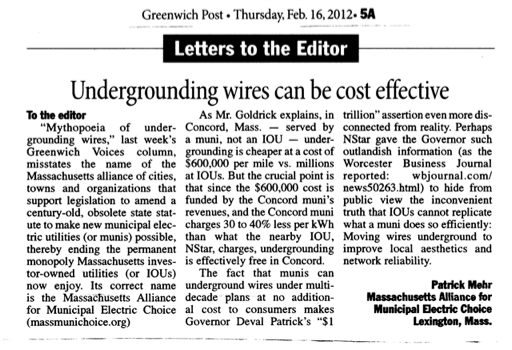

|
As the saying goes, each is entitled to his own opinion, but not his own facts. Yet when it comes to putting electric wires underground, “undergrounding,” in industry parlance, the facts are difficult to pin down.
At a Greenwich public hearing last year, representatives from CL&P asserted that it would cost $3.3 million per mile to underground electric wires in Greenwich. I followed up with CL&P engineer John Siclari who stated that the $3.3 million figure is based on a “blended average” of estimates. Tom Dorsey, CL&P manager for government relations, admitted that the figure is not based on an estimate for Greenwich, or for Connecticut, but comes from estimates in other states. Dorsey pointed to a 2009 study by the utilities industry-funded Edison Electric Institute which put the cost of undergrounding overhead wires at a maximum of $2.1 million per mile. Dorsey contends that undergrounding in Greenwich could cost more due to the town’s being “filled with rock ledge.” Yet CL&P has yet to perform an estimate for Greenwich or this region.
Is undergrounding prohibitively expensive? Governor Malloy’s Two Storm Panel report says “no.” The panel found that, “the cost of undergrounding cables in many areas... is not drastically different from that of above-ground utilities,” and recommended that “undergrounding be immediately studied by the DEEP in the areas discussed by the panel and the utilities.” The Witt Associates study also concluded that Connecticut should go forward with undergrounding, and further concluded that undergrounding substantially protects electric lines from common damage, including from severe storms. But the EEI study described that as an “urban myth.” Who’s right?
Panel member Joe McGee stated that in the last 20 years, technology advancements have largely solved the problems of damage to undergrounded wires from moisture and other elements. Regarding the cost of undergrounding, CL&P’s Dorsey wrote that, “the cost is something that any community has to consider given all the other needs that must be faced.” But McGee disputes the notion that the community must pay every penny for undergrounding. The Two Storm Panel asserted that the cost “should be shared between ratepayers and CL&P parent company Northeast Utilities’ shareholders.” NU earns a return on equity of nearly 11%. That is substantial, given that inflation is barely 2%.
McGee also points out that undergrounding substantially lowers the life-cycle cost of the electric wires, and that savings from substantially lower maintenance costs could be passed on to ratepayers.
Undergrounding is not foreign to New England. Concord, Massachusetts’ municipality-owned utility is in the process of undergrounding all of its electric wires at a cost it says is just $600,000 per mile. Massachusetts Governor Deval Patrick suggested that undergrounding could help prevent future outages. NStar, however, gave an estimate of $1 trillion for undergrounding all the state’s overhead wires, which Massachusetts Alliance for Electric Choice’s Patrick Mehr called inflated by more than 10 times. NStar later backed down, saying the figure “was not a formal estimate.”
The truth about undergrounding is that it is likely to cost far less than the utilities are telling us, it will reduce outages, and the utilities will fight it every step of the way.
Sean Goldrick is a Democratic member of the Board of Estimate and Taxation, though the opinions expressed in this column are his own. He may be reached at sbgoldrick@gmail.com.
|







